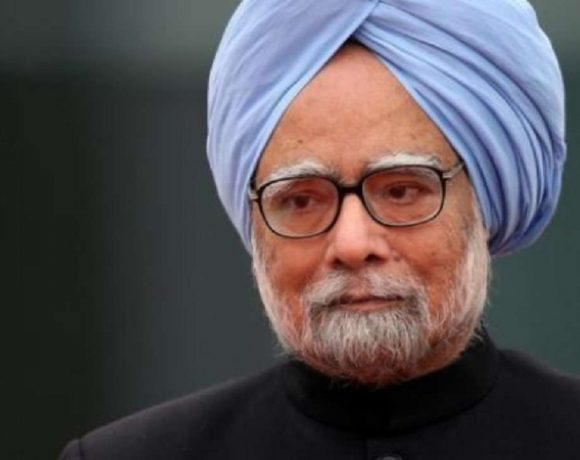

t is now the world’s fastest growing large economy. The International Monetary Fund (IMF) estimates that India surpassed China’s domestic growth last year for the first time and will expand 7.4 percent this year compared with China’s 6.5 percent. By 2018, the IMF predicts that gap will widen as Indian expansion hits 7.6 percent while China slows to 6 percent. (The other two large emerging markets — Brazil and Russia — are struggling with less than 1 percent annual growth predicted through 2020.)
India has a young, hard-working labor force with favorable demographics — its average age is 27 compared with China’s 37, our 38, Europe’s 43 and Japan’s 46. Last year, world No. 1 China’s population was 1.37 billion, 90 million more than runner-up India’s 1.28 billion.
Given India’s annual population growth of 1.41 percent compared to China’s 0.51 percent, it be the world’s largest country by 2030.
At least a decade or more behind China, “India’s consumption lifecycle is still in its infancy, and there is massive potential to grow rapidly. Also on track is the revival of the manufacturing sector, which would support sustainable growth and job creation.” (EGA Investment Strategy Commentary, April 2016, p. 1).
India lags far behind China because it wasted nearly 50 years after gaining independence from Great Britain in 1946. Its first leader after independence, Jawaharial Nehru, and later, his daughter Indira Gandhi, were committed socialists who supported tariffs to limit foreign trade. It wasn’t until the mid 1990s that India began to open up its economy. The Chinese began their switch to promoting capitalistic growth much earlier, in 1979.
However, India did not have a leader committed to cutting government regulations and reducing its deficit until Modi was elected prime minister two years ago. His overwhelming win propelled the top India 50 stock ETF (PIN) to a 33 percent gain in 2014, However, Modi has struggled to overcome the entrenched Indian bureaucracy and political opposition in Parliament. Last year, India’s top 50 stocks lost 8 percent and have only gained 1 percent this year through May 31.
Amazon has invested $2 billion in India and just announced it would commit $3 billion more to expand its presence there. Indian consumers are just beginning to embrace internet shopping. The World Bank estimates that Indian online retail sales will grow from $6 billion last year to $70 billion by 2020.
The robust headline number, despite faltering private investment, weak capital goods growth and shrinking exports, has reinforced expectations that the RBI would keep its policy rate on hold at its next quarterly review next Tuesday. The central bank has already cut its policy repo rate by 150 basis points since January 2015, reducing it to 6.5 per cent — the lowest level in more than five years.
The strong 7.9 per cent growth in the fourth quarter comes at a time when China has reported a 6.7 per cent in the March quarter — its slowest growth in about seven years.India’s poor infrastructure has limited the growth of manufacturing and value-added agriculture. Its 2016-2017 government budget projects a huge 22.5 percent spending increase on total infrastructure investment. (Almost all U.S. economists support significant increased government infrastructure spending, but, as usual, the Washington politicians can’t agree.).
Investing in India is high-risk but provides excellent diversification away from the U.S. market. I have owned two excellent no-load India funds for more than two years — Matthews India (MINDX, 800-789-2742) and the higher-risk, smaller-company-oriented Wasatch Emerging India (WAINX, 800-551-1700).
With India now acknowledged as the fastest growing large economy in the world and also edging up in the World Bank’s ease of doing business rankings, the time is ripe for the country to open its doors wider to Foreign Direct Investment (FDI). This is exactly what the Centre has done by raising FDI caps in some sectors (airlines from 49 to 100 per cent), sweeping others entirely into the automatic route (cable TV, brownfield airports) and diluting preconditions for sectors with restrictions (relaxation of sourcing norms in single-brand retail and technology norms for defence). FDI is stickier and more resilient to business cycles than mercurial Foreign Portfolio Investor (FPI) flows. At a time when the private sector has a limited appetite to invest and when the government is tied down by fiscal constraints, India needs to seek out foreign capital to keep its growth engines purring. That foreign investors are interested in India is evident: there has been a 23 per cent surge in inbound FDI, which touched a record $55.5 billion in 2015-16.
Even so, it is simplistic to assume that merely opening up more sectors or setting more liberal equity caps will have foreign investors queuing up to invest. India’s experience suggests that actual investment interest in the newly liberalised sectors will be tied to three factors. One, foreign investors, like domestic ones, are ROI (Return on Investment) focussed. Therefore, sectors that are already witnessing booming consumer demand — such as DTH television, airlines and pharmaceuticals — are more likely to attract quick investment flows than those that are in need of bailouts (asset reconstruction firms) or entail long gestation periods (airports or defence). Two, even if the Centre is willing to reduce initial entry barriers, frequent market or pricing interventions can deter investors. The Centre seems to have recognised this in watering down the sourcing norms for FDI in single-brand retail. But its attempts to woo FDI into pharma may be stymied by increasing price controls and the lack of clarity in the policy on essential drugs. Three, the experience with sectors such as insurance suggests that foreign investors committing long-term capital expect to exercise control over the entities they fund. Overall, there is no disputing that the FDI relaxations, irrespective of whether they were timed to signal the Centre’s commitment to reforms in the face of RBI Governor Raghuram Rajan’s exit in September, are a step in the right direction. But as we have learnt from the past, the devil is usually in the detail.
While the economy is still hampered by the country’s infrastructure deficiencies and sprawling bureaucracy, the changes represent a greater shift away from the socialist and protectionist policies of India’s modern post-independence history. The new rules will allow foreign investors to establish 100 percent ownership in companies involved in defense, civil aviation and food products, although with government approval.
Foreign investors will also be permitted to buy up to 74 percent of Indian pharmaceutical companies without seeking government approval. The government similarly relaxed regulations that had made it difficult for companies like Apple and Ikea to establish retail operations in India.
The election of Prime Minister Narendra Modi in 2014 was widely expected to lead to more market-friendly policies, which he had championed in his years as the chief minister of the state of Gujarat.
The delay in bringing them about had led to widespread criticism that Mr. Modi was not moving fast enough to stimulate the economy.India’s latest reports on job creation may have tipped the scales in favor of further economic liberalization, some experts said. Domestic data showed weak employment numbers in the last quarter of 2015 in jewelry, automobiles and information technology, compared with a year earlier.
The timing of his announcement was almost certainly aimed at reassuring international markets. The rules were rolled out just two days after the surprise resignation of the widely respected chairman of the central bank, Raghuram G. Rajan, whose departure has prompted uncertainty about the government’s reform plans.”Modi needed to send some signals to show government is bringing in economic reforms and they will happen with or without Rajan,” said Harsh V. Pant, a professor of international relations at King’s College in London. “The government is trying to recapture its mojo on the economic front.”
Mr. Rajan, a popular figure among foreign investors, had enhanced India’s standing in international markets. But he had become controversial domestically, in part because of his crackdown on the debt-strapped banking industry and because critics wanted him to lower interest rates faster to stimulate domestic growth. His announcement that he would leave his job as governor of the central bank implied that he was moved at least in part by the preferences of the government of Mr. Modi.
India began life as an independent country in 1947 with a heavily controlled, protectionist economy. It changed course in 1991 when a balance-of-payments crisis forced the government to loosen its controls on industry and reduce barriers to imports, among other things.
Those changes are credited with spurring India’s transformation into the fastest-growing large economy in the world. But its growth rate of 7.6 percent is too slow to provide jobs for the one million people entering the work force each month. The previous government, and Mr. Modi’s, had promised further liberalization.
Mr. Modi has struggled to enact the major changes he promised, such as making it easier for companies to acquire land, because his party does not control the upper house of Parliament. Monday’s policy shifts required only the approval of his top administration.
The latest changes in foreign direct investment (FDI) norms in India have made entry and control of foreign investors in a lot of sectors easier. Defence and civil aviation have been opened to 100% FDI under the government approval route (the FDI limit was 49% in airlines before). Many other sectors have been allowed 100% (or near 100%) FDI with government approval or through the automatic approval route. These include animal husbandry, trading of food products produced in India (including through e-commerce), private security services and broadcasting carriage services (such as DTH, cable networks and mobile TV). Up to 74% FDI (against the previous 49%) in brownfield pharmaceutical industry projects will no longer require government approval. Brownfield airports too have been brought under the automatic approval route.
The condition of access to state-of-the-art technology in India has been removed in defence. In addition, for single-brand retail trading companies undertaking business with state-of-the-art technology, the restriction of sourcing up to a certain percentage of inputs locally has been totally relaxed for three years, followed by a partial relaxation for another five years – a favour granted apparently on Apple’s appeal.
The stated objective of 100% FDI and other relaxations is to promote employment and improve infrastructure, along with greater FDI inflows and the ease of doing business in India. An official statement said that with most sectors coming under the automatic approval route, India is now the most open economy in the world for FDI.
Why this move will hurt India’s interests
While the latest FDI policy change will certainly boost FDI inflows and increase the ease of doing business in India, it is doubtful whether it will promote other more important socio-economic objectives. On the contrary, it might hurt them. Here are some of the major impacts.
Domestic economy, employment and economic security of people: Rather than promoting employment, these FDI relaxations might accelerate the ongoing trend of jobless growth and rising inequality. With 100% FDI owned commercial entities, a much greater share of returns on investments will go outside India, decided based on business preferences of foreign owners. Therefore, multiplier effects of financial returns on the economy and employment will be limited. Relaxation of local sourcing restrictions will further add to the dampening of multiplier effects.
Infrastructure: It is inexplicable why infrastructure cannot be improved without FDI relaxation. India’s infrastructure in major sectors including civil aviation and broadcasting services has already been witnessing substantial investments, growth and modernisation. There are several Indian firms, both public and private, which have demonstrated a long experience of building facilities and networks with modern technology and systems, through either sole ownership or joint ventures. In infrastructure requiring the latest technology, growth could easily have continued through joint venture mechanisms.
Agricultural economy and families dependent on it: Hundred percent FDI in animal husbandry, retail and trading of food products might lead to greater consolidation and control of farmland and other agricultural assets in the hands of large corporations. This will make a majority of small farmers and farm-dependent families more vulnerable and accelerate distress migration to cities. Alternately, the policy change should have been directed at improving economic security and technological skills of small farmers and farmers’ cooperatives.
Small manufacturing and services industries: Relaxation of local sourcing norms for state-of-the-art technology based retail trading companies will subdue opportunities for suppliers to increase their business and upgrade technology skills. Small industries, most of which are suppliers to larger firms, constitute an overwhelming majority of India’s industrial base. A policy that goes against their interest is therefore detrimental to the ‘Make in India’ agenda.
Manufacturing and services industries where Indian firms have already demonstrated near world-class competence: There are industries where some Indian firms have proven high competency in technology and management. These include existing parts suppliers in the defence industry. They also include parts suppliers in the automotive industry, several of whom have the ability to upgrade and potentially supply to defence and civil aviation sectors. Additionally, raw material as well as finished product manufacturers in pharmaceuticals and a lot of retail industries have vast experience of selling high quality products and services. Airlines services and airport projects in India too have established domestic players with track records of efficient and high quality performance in services and projects involving complex operations and technology. Similarly, there are routine service industries, such as private security, that have witnessed the emergence of domestic firms with professional work standards and management systems. And there is reasonable domestic competition in these industries. The Indian pharmaceutical industry is known for reverse engineering, efficient operations and technological skills and is a major supplier of affordable medicines to many third world countries. In this scenario, what substantial benefit will 100% FDI bring? Instead, the effort should be to equip well-performing domestic firms to become globally competitive and increase their exports. That will boost the economy and employment, and upgrade technological skills.
Domestic R&D and manufacturing capability in state-of-the-art technology areas: Removal of the condition of access to state-of-the-art technology in India in the defence sector and waiver of the minimum local sourcing condition in single-brand retail with state-of-the-art technology has directly hurt the opportunities for building those higher-end capabilities among Indian industries and entrepreneurs. Rather than allowing foreign companies to bypass domestic suppliers while doing business in India, they must be asked to integrate domestic manufacturers and service providers within their supply chains so that they contribute directly to building India’s economy as well as technological competence. Achieving higher value and creating capability through technology and innovation must be as important a goal for India’s economy as universal employment generation. Unfortunately, both have been side-stepped.
FDI should support and be subservient to, rather than dictate, socio-economic development
A deeper concern is that our developmental priorities, as reflected in drastic FDI relaxations, appear fundamentally misplaced. While ‘ease of doing business’ is a desirable thing, in India’s case it is being promoted at the expense of other more important national objectives such as employment; survival and skill upgradation of agricultural and small manufacturing economies and families dependent on them; expanding on existing domestic capacities in those industries where Indian firms have already demonstrated competence; and development of domestic R&D and manufacturing capability in state-of-the-art technology areas. FDI should be subservient to, and support, these more important socio-economic goals. The ongoing development policy, by promoting FDI at the expense of these goals, is in fact really not for development.
By and large, democracies with high income and low social strife are the ones which have opened their economies to foreign capital in a major way only after achieving a reasonable degree of domestic economic stability, industrial technological competence and overall prosperity. Opening a large economy to foreign investments without either adequate checks or having a strong domestic economy of suppliers, markets and technological capability is akin to fattening a person by injecting drugs. It is a short cut to growth, but one which will yield an economy that is inherently weak and vulnerable. It is also likely to produce a society beset with economic fault-lines that constantly trigger social conflicts – a phenomenon that might intensify beyond the levels we have witnessed in the past.



















